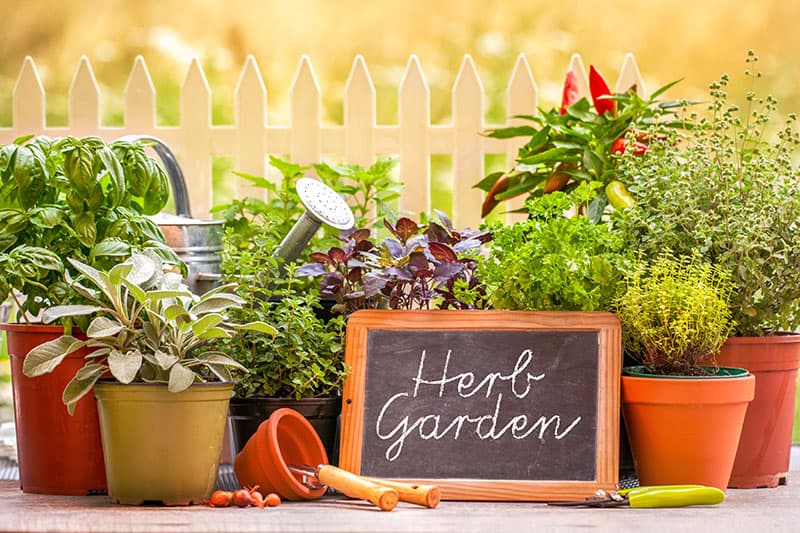Grow Herbs In Your Garden
You don’t have to live in the country to have a country style herb garden. Actually I saw some of the most charming herbal gardens in the 8-foot-square. Even a planter box or a series of large pots can provide enough space for herb gardening. My first garden held forty different herbs in an eighteen square foot plot
An herb garden will give you pleasure throughout the year. Spring contains the excitement of plants emerging from the earth with bursts of energy. The summer garden is filled with beauty and fragrances. Autumn brings the bountiful harvest. Winter is a time for dreaming and planning and enjoying all of your dried and preserved herbal creations.
Herb Gardening
An exciting facet of herb gardening is the design. This is your chance to be an artist, using nature as your canvas. Nature itself is your assistant, since herbs have a way of creating beauty no matter how they are combined. Still, certain techniques can make your garden especially attractive. The fun in planning is choosing and putting together different elements to create your own unique style.
READ ALSO: 7 Best Alternatives to Solarmovies for Watching Movies Online
Country Herbs Gardens
Country herb gardens are versatile. They can be grown on a terraced slope, in a border wrapped around the side of a house or lawn, and even in pots on your porch or balcony. Basic design for a garden is like any art. You create a contrast in color, texture, and form. The most appealing herb gardens keep your eye moving from bed to bed in visual delight. The herbs themselves offer much to work with.
Design inspiration can come from many sources: a diagram of a traditional herb garden, gardens you visit, and nature. An excellent place to see garden design in action is in established herb gardens. Find them a historical homes, herb nurseries, botanical gardens, museums, herb shop, and private homes. Your visits will help you choose favourite varieties and get a feel for which herbs are best for your particular garden. Local herb and garden societies have a wealth of information about local growing conditions and sources of plants.
Sketch Your Garden Designs
Sketch your designs on paper, where they can be easily changed. Once you choose a final plan, lay out the garden with strings tied to stakes so you can walk through and visualize your dream garden. Make sure that pathways are wide enough to allow herbs to trail and bush out into them. Check to see that the herb beds are a convenient size for harvesting.
READ ALSO: which Entrepreneur made Tractors before entering the Sports car Business?
Herb gardens are for enjoyment, so have fun with them from the beginning. While designing your herb garden, keep in mind that you can always make changes. Even well-established herbs can be moved after they are planted. If you think the tansy has become ungainly, as it tends to, or the pink yarrow might look better next to lavender than it does to sage, dig them up and move them. A small herb garden can always be enlarged and an area overgrown with weeds can be dug up and replanted.
Choosing the herbs
Herb Gardening
A combination of tall- and low –growing herbs create depth and variety in your garden. Tall fennel and angelica and small trees and bushes such as bay, juniper, and myrtle, add more dimension to your garden. You must know how tall and wide your herbs will grow. Hence you will not surprised one day to find the little penny royal and sweet woodruff hidden by an overbearing wormwood. The simplest designs place large herbs in a central location or in the back row, then work down in height to the smallest herbs.
Colorful Herbs
Colors can contrast strongly, moving gradually from softer hues to a brighter crescendo, or they can follow the color wheel. Herbal leaf colors range from soft blue-grays to yellow greens, and they exhibit a variety of textures. Through many herb followers are small, they often are so numerous that they seem to cover the entire plant.
A rambling thyme plant in ful bloom looks like a floral carpet.
Herbs like Echinacea and calendula provide large, bright blooms.
Don’t hesitate to include the colorful accents of non-herbal flowers, such as daisies, cosmos, blush roses, bachelor buttons, and zinnias, because they provide additional color for your herbal crafts projects.
Subtle color contrasts can work well if the herbs present a variety of textures. In the Caprilands of Connecticut, one of Aldema Simmonsj’s best-known herb gardeners has grey and grey herbs.

